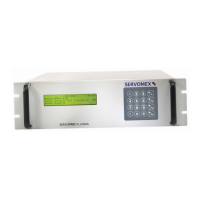User Manual SERVOPRO PLASMA Trace N
2
Analyzer
APPENDIX 6
81
Before trying to fix leaks, this test can be done using different gas sources i.e. zero calibration gas, span gas,
normal sample etc. Of course if the same leak is observed for any of the gas sources we will look for the
source of this leak in a part of the gas circuit which is common to all the streams and so on. We have to
notice that during this test, the conditions have not changed in the zone 2 i.e. downstream the flow module;
except if we have caused an important flow change by dropping the pressure too low. A good system will
not show a noticeable change in signal (<0.5 ppm) while running it at low or high pressure. Of course we
easily understand that presence of leaks will bring unreliable calibrations, erratic sample analysis results and
all the nightmares that come with all that. The only solution is a good tubing and sampling system.
TEST FOR ZONE 2
Prior to run this test, make sure that the analyzer is running under gas since at least 2 or 3 days. Doing this
test on a newly installed analyzer could give false results since the analyzer’s dry down is not done yet.
Therefore this test will be simply done by changing the flow and checking for signal change. If there is a
leak we will observe mainly a leak dilution phenomenon. Usually a leak brings in a certain amount of
impurity, no matter how high or low is the flow in the tubing. Since we will run this test with the zero gas,
presence of a leak will be confirmed by an increase in reading when dropping the flow (less diluted
contaminant) or decrease in reading when increasing the flow.
N.B.: The inlet pressure should be normal (between 5 and 15 PSIG) when running this test otherwise with a
low inlet pressure we would observe the dilution of a leak that could be located in zone 1.
N.B.: to change the flow, you have to go to configuration menu (F1), push the digit keys ex. 2, 5, and push E
for Enter to get a flow of 25 ml min
-1
(25 cc/min).
When changing the flow from 75 ml min
-1
(75 cc/min) to 25 ml min
-1
(25 cc/min) an increase in the reading
of no more than 0.25 ppm should be observed. If the presence of a leak is detected try to retighten each
fitting one by one (4 nuts total), and wait 10 seconds between each tightening to see if there is a change in
the reading.
One could ask how come he should check these fittings since the analyzer’s manufacturer should have
installed them correctly. It is a fact that when a
SERVOPRO CHROMA
leaves the factory it has been
thoroughly checked and there was no leak inside since we are aware of leak problems and we know very
well how to track them. But here is what experience shows about compression fittings:
- When fittings are newly installed according to manufacturer’s specification (Swagelok, Parker,
Valco, etc) they most of the time show no leak, except if some irregularities are present (scratched
tubing, dirt or dust on the ferrule, etc.). Anyway, these possible problems have been checked and
solved at Servomex Canada factory (regarding the analyzer itself).
So a properly installed fitting, when tightened, is preloaded i.e. there is a permanent pressure applied on the
front ferrule against its seat providing therefore a good sealing. Overtime, in the real life, what happens?

